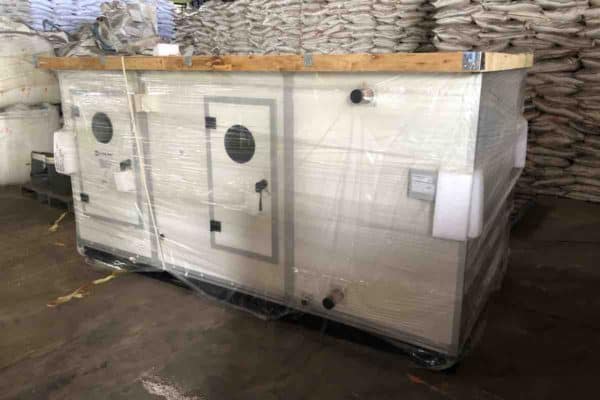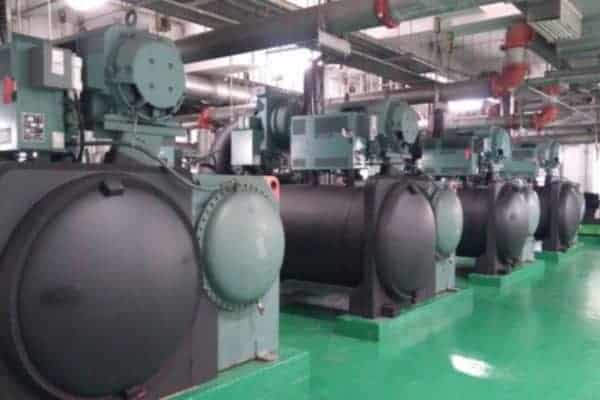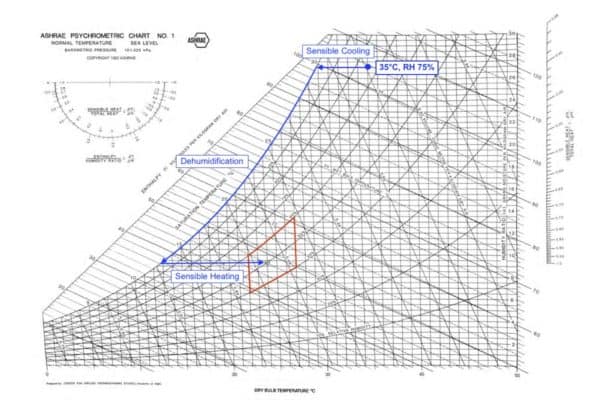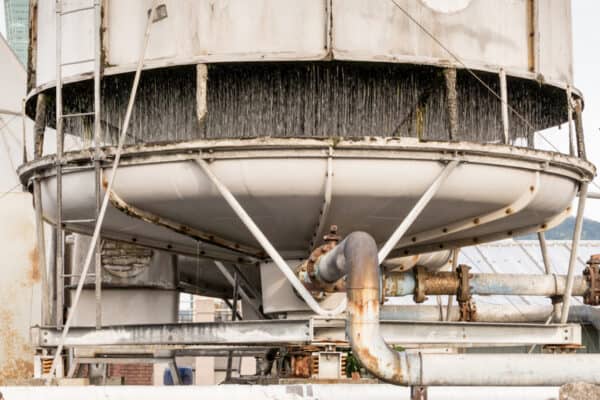How to Size Cooling Tower Make Up Water Tank?
The make-up water tank is one of the major pieces of equipment in chilled water systems. Its job is to replenish water to cooling towers when the condenser water evaporates to the surrounding. I happened to have experience in sizing cooling tower make-up water tanks. So, let’s go through the process.
Before I start, make-up water tanks are not expansion tanks. Expansion tanks or buffer tanks are used to store extra water volume due to thermal expansion. Make-up water tanks are used to replenish condenser water at cooling towers.
1. Determine the Condenser Water Flow Rate
The first step to estimate cooling tower make-up water tank size is to determine the condenser water flow rate. Usually, you can get the condenser flow rate by referring to the water flow rate of cooling towers.
Then, add the water flow rate of each cooling tower to get the total condenser water flow rate.
However, if there is a backup cooling tower that runs only when one of the cooling towers is malfunctions, don’t add the water flow rate of the backup cooling tower.
For example, a cooling tower has a water flow rate of 1,856 gallons per minute (gpm). I have a total of 5 cooling towers and one of them is a backup. Hence, the condenser water flow rate is 7,424 gpm.
If you haven’t got your cooling towers selected or designed, you may refer to the datasheet of the chiller to obtain the required condenser water flow rate.
Alternatively, you may use a rule of thumb of 3 gpm per refrigerant ton (RT) of cooling capacity.
For example, my building needs 2,400 RT of cooling capacity. Using the rule of thumb, my estimated total condenser water flow rate is 7,200 gpm. Not too far from 7,424 gpm.
2. Identify the Make-Up Loss
Make-up loss is the amount of water loss due to evaporation, drift and blowdown. At the cooling tower, condenser water is splashed onto the fins of the cooling tower to increase the contact surface for evaporative cooling.
Naturally, evaporative cooling causes some amount of water to evaporate into the ambient air. Besides, cooling towers occasionally blowdown or flush out condenser water when there are a lot of minerals formed or simply “dirty”.
Thus, some people said chilled water systems “consume” water because of that.
Make-up loss is expressed in the percentage of water loss per minute. Typically, it is within 0.98-1.10% of water loss per minute.
If you have the datasheet of cooling towers, it usually stated the make-up loss in percentage. Otherwise, add all three water losses (evaporation, drift and blowdown) to get the make-up loss.
Once you got the make-up loss percentage, multiply it with the total condenser water flow rate and convert it into flow rate per hour.
For example, I have a total condenser water flow rate of 7,424 gpm. My make-up loss is 0.98%. Hence, the amount of water loss per minute is 72.75 gpm. The water loss per hour is 4,365 gallons per hour (multiply by 60 minutes to convert).
3. Estimate Daily Operation Hour
Now, we need to estimate how many hours the chilled water system operates per day in order to estimate the total make-up water required per day since we know how much is water loss per minute.
You may start by asking your client how they operate the building, what’s the working hour. Otherwise, you may use the typical 8am to 10pm operation hour.
Once you have the daily operation hour, multiply it with the amount of water loss per minute to get the make-up loss per day.
For example, my building needs the chilled water system to run from 8am to 10pm. That’s 14 hours of operation per day. Hence, the amount of water loss per day is 61,110 gallons of water.
On a side note, if you want to quickly learn about chilled water system, you can get my Chilled Water System (eBook). If you’re into design, you can enroll in my Chilled Water System Design Course where I teach you various design procedures with tons of examples.
Chilled Water System Design Course
Learn how to design a chilled water system with AHU/FCU selection, chiller sizing, cooling tower sizing, pump sizing, piping design, ductwork design and more.
4. Decide to Reserve How Many Days of Water
We know that the amount of condenser water loss per day is 61,110 gallons of water. Before we estimate the make-up water tank size, we need to decide that if there is no water supply to the make-up water tank, how many days we can run the chilled water system before it dries up.
If you think that the water supply to the make-up water tank is not a problem, you can reserve 1 day of water. Usually, we only reserve 1-2 days of water.
Remember that this greatly impacts the make-up water tank size and thus, the cost and the weight. The roof structure may not be designed for such a heavy load. Do check with the structural engineer.
Once you’ve decided to reserve how many days of water, multiply it by the amount of water loss per day.
For example, I decided to reserve 1 day of water for my make-up water tank in case there is a problem with the water supply to the make-up water tank.
So, the total make-up water volume required is 61,110 gallons of water.
Now, convert the result to cubic meter or cubic feet for the tank sizing. You can use any online converter to do. For example, my 61,110 gallons of water is equal to 231.28 m3.
5. Add a Safety Factor
To account for the temperature and humidity fluctuation and other factors which affect the make-up loss, we should add about 5-10% safety factor to our final result.
For example, I decided to use a 10% safety factor. Hence, the required make-up water volume is now 254 m3.
6. Choose the Material for the Make-Up Tank
The make-up water tank is sized by the number of panels. Different materials have different panel sizes.
Usually, HVAC make-up water tanks are made of either fiber panels or steel panels. Each fiber panel dimension is 1 meter by 1 meter (width x height) and each steel panel dimension is 1.22 meters by 1.22 meters (width x height).
For my make-up water tank, I think steel panels are cool.
So, I’ll use the dimension of the steel panel for my final step which is to estimate the make-up tank size.
7. Find the Make-Up Tank Size
When finalizing the make-up tank size, keep in mind that the height of the tank should not be more than 3 panels whether it is a fiber panel tank or steel panel tank.
However, with extra supports and concern from related parties, water tanks height can go up to 4 panels. I never see any water tanks exceed 4 panels in height.
Besides, water tanks always have a concrete plinth or I-beam to lift the tank up about 450-600mm above the ground in order for people to crawl underneath the tank for installation and maintenance.
Hence, be careful not to exceed the height limit and crash with the services above the make-up water tank. If your tank is located on the roof, check with the architect on the building’s maximum height limit although your tank hardly is the highest point but just in case.
Most make-up water tanks are square in shape but it doesn’t really matter as long as you utilize the space effectively. Personally, I like to make them in a rectangular shape.
For example, my required make-up water volume is 254 m3. Hence, my make-up water tank size can be either 5x10x3 or 7x7x3 (width x length x height expressed in numbers of steel panels).
Keep in mind that 5x10x3 or 7x7x3 is the number of steel panels. It may not be the same for fiber panels since the dimension per panel is not the same.
When convert into physical tank size, 5x10x3 translates into 6.1 (W) x 12.2 (L) x 3.66 (H) meters since steel panel dimension is 1.22 meters by 1.22 meters per panel.
Because the make-up water tank is an open tank, we need to account for the effective water height. A 3 meters tall tank does not have full 3 meters water. Usually, it has about 2.6 meters of water only.
So, when you are matching your required water volume with the tank volume, always estimate the water height to be 2.6 meters instead of 3 meters.
For example, a 5x10x3 steel panel tank has a gross volume of 272 m3 but it has a net volume of 236 only and it is slightly below the required volume which is fine.
Let say I have a 600mm concrete plinth for the make-up water tank, the water tank physically occupies 6.1 meters of width, 12.2 meters of length and 4.26 meters of height excluding valves and maintenance clearance.
For make-up water tanks, you may allow clearances of at least 450mm for walking space, 1000mm for climbing the ladder and 600mm above the tank for valves and inspection.
In addition, if you multiply the required make-up water volume by 1,000 kg per m3 (water density), you’ll get the estimated weight in kg. The tank itself is actually not that heavy compared to the water it holds.
Moreover, structural engineers appreciate if your make-up water tank is wider/longer instead of taller because their concrete slabs are not good for point loads.
Once again, you can get my Chilled Water System (eBook) to quickly learn more about chilled water system. But, if you want to learn how to design a chilled water system from start to end, I encourage you check out my Chilled Water System Design Course.
Chilled Water System Design Course
Learn how to design a chilled water system with AHU/FCU selection, chiller sizing, cooling tower sizing, pump sizing, piping design, ductwork design and more.
If you have anything to add (or ask) about this topic, leave a comment down below!









